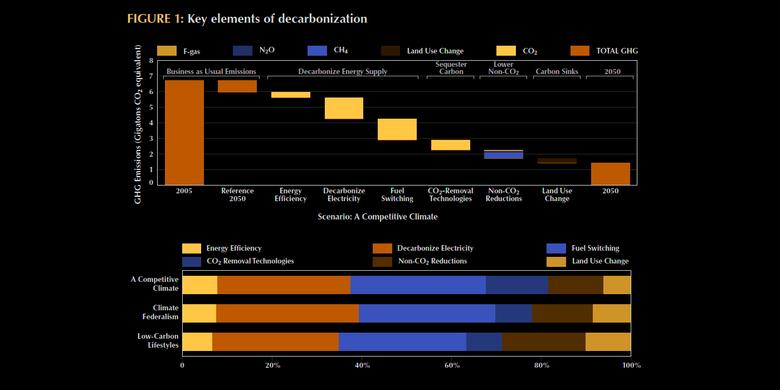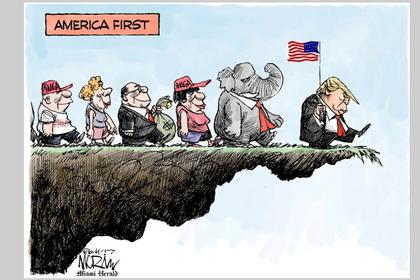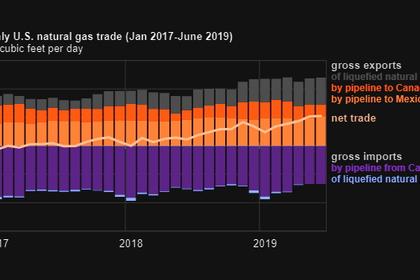
U.S. DECARBONISATION 2050

C2ES - GETTING TO ZERO: A U.S. CLIMATE AGENDA
EXECUTIVE SUMMARY
This report outlines a comprehensive agenda for decarbonizing the U.S. economy by 2050, with an emphasis on priority actions needed over the coming decade. This agenda was developed in close consultation with leading companies in key sectors through the Center for Climate and Energy Solutions' (C2ES's) Climate Innovation 2050 initiative. It builds on an earlier report, Pathways to 2050: Alternative Scenarios for Decarbonizing the U.S. Economy.
A strong body of scientific evidence underscores the imperative of decarbonizing the global economy in order to avoid the worst potential impacts of climate change. Key strategies for achieving that goal include increasing energy efficiency, decarbonizing the power sector, switching to electricity and other low- and zero-carbon fuels, reducing non-CO2 climate pollutants, and using both nature and technology to remove carbon from the atmosphere.
In the United States, achieving net-zero emissions by 2050 will require action across society—by governments, the private sector, and the public at large. It will require both innovative technologies and strong policies to ensure they are deployed. And apart from reducing the grave risks of climate change, it will provide a strong foundation for continued U.S. growth and competitiveness.
Getting to Zero: A U.S. Climate Agenda recommends that a U.S. decarbonization strategy be guided by these key objectives: achieving net-zero emissions no later than 2050, reestablishing U.S. global leadership on climate change, developing and mobilizing a broad array of technological solutions, promoting cost-effective solutions, protecting and enhancing U.S. competitiveness and energy security, ensuring an equitable transition, strengthening climate resilience, responding to new information and circumstances, and providing predictability to drive long-term
investment.
With these objectives in mind, Getting to Zero outlines a comprehensive set of policies needed over the coming decade to put the United States on the path to carbon neutrality. At the core of this policy agenda is a long-term federal framework, including an economy-wide carbon pricing program. The agenda also includes many complementary federal, state, and local measures addressing key sectors: power, transportation, industry, buildings, land use, and oil and gas. In addition, the agenda offers recommendations to drive innovation, mobilize finance and ensure a just transition, and advance especially critical technologies.
Finally, the agenda recommends steps that companies should take, recognizing the critical role of the private sector in leading the climate effort. The diverse array of policy approaches recommended here are intended to work in concert to address the many facets of the overall decarbonization challenge. While a robust carbon price will send a broad signal across the economy to reduce emissions, companion policies, from the federal to the local, will help mobilize private investment, ensure that the necessary technologies and infrastructure are in place, and provide targeted incentives to both companies and consumers to accelerate the transition. The nature of these companion policies varies across sectors, and their precise mix and timing will depend in part on how quickly a meaningful carbon price is put in place. But for any given sector, it is the totality of these approaches working together, rather than any single policy, that will produce the necessary results.
The agenda's core, sectoral, cross-sectoral, and business-focused recommendations are briefly summarized below.
CORE ELEMENTS
Establishing a Long-Term Framework
• Congress should set a national goal of making the United States carbon neutral no later than 2050 and establish an overarching statutory framework for achieving carbon neutrality, including a comprehensive review of progress every four years.
• Congress should vest the President with the statutory responsibility to direct a phased effort across the federal government toward meeting the goal of carbon neutrality.
• Congress should enact an economy-wide market-based policy that effectively puts an escalating price on carbon and other major greenhouse gas emissions.
Driving Innovation
• Congress should establish decarbonization as a principal objective of the research mission of all relevant federal agencies and should direct the White House to lead an interagency innovation effort, including research, development, demonstration, and deployment strategies aiming for carbon neutrality in the transportation, power, buildings, industry, land use, and oil and gas sectors.
• Congress should ramp up funding for climate-related research and development to at least $20 billion per year by 2030, including $2 billion per year for the Advanced Research Projects Agency–Energy, and should provide $50 billion to $100 billion over the next decade for high-impact demonstration projects.
• The federal government should strengthen administrative capacity and management practices to ensure the efficient and timely use of research funding and should consult closely with the private sector and other nongovernment stakeholders in developing and executing the low-carbon innovation agenda.
Mobilizing Finance
• Congress should direct the Securities and Exchange Commission to require public companies to disclose material climate-related financial risks under a range of climate scenarios and their strategies for managing those risks.
• Congress should require the Federal Reserve to integrate consideration of climate-related risks into the periodic stress testing required of major financial institutions.
• Congress should create a national green bank to leverage private investment in clean energy, energy efficiency, and other activities contributing to decarbonization. More states and localities should also create green banks for use in their own markets.
Ensuring a Just Transition
• Policies that could increase the cost of energy should include mechanisms to minimize any cost burden on lowincome populations and small businesses.
• A share of climate investment should be dedicated to deploying solutions and infrastructure in historically marginalized communities, including urban tree planting, energy efficiency retrofits, community solar, electric vehicle charging, and low- and zero-carbon public transit.
• Congress should increase support to communities in transition to train workers and foster new industries that can contribute to a stable economy and tax base.
SECTORAL ELEMENTS
Power
• Congress should provide a range of tax credits for zero-carbon generation and should mandate the use of carbon capture or corresponding sequestration-based offsets for all fossil fuel-fired power generation by a date certain.
• In the absence of meaningful economy-wide carbon pricing or a national clean energy standard, all states should adopt ambitious clean energy standards that can be met by the full range of zero-carbon technologies, including renewables, nuclear, large hydro, and fossil fuel generation with carbon capture.
• Congress should direct the Federal Energy Regulatory Commission to develop a comprehensive, long-range infrastructure strategy and should prioritize the siting of "climate-critical" infrastructure. The commission also should reform wholesale power markets to more explicitly value the low-carbon, capacity, and reliability attributes of competing power sources.
• State public utility commissions should work with the power sector to help facilitate the electrification of other sectors.
Transportation
• Congress should direct the Environmental Protection Agency to establish a greenhouse gas performance standard ensuring that half of new light-duty vehicle sales are zero-emission vehicles by 2035, and a similarly ambitious standard for medium- and heavy-duty trucks.
• Congress should extend the current electric vehicle tax credit, make it available as a point-of-sale rebate, and expand it to include all new zero-emission vehicles, including fuel cell electric vehicles and medium- and heavyduty trucks.
• States should develop comprehensive long-range plans to accelerate the deployment of zero-emission-vehicle charging and refueling infrastructure. Congress should fund the development of these state plans and should provide funding to states that have plans to construct charging and refueling infrastructure.
• Local governments should—with dedicated federal planning support—develop integrated transportation and land use plans that expand non-automotive transportation options in order to strengthen mobility while reducing congestion, air pollution, and carbon emissions.
• Congress should establish a performance standard that freezes aviation emissions at 2020 levels, allowing for the use of biofuels and offsets, modeled on the Carbon Offsetting and Reduction Scheme for International Aviation.
Industry
• Congress should increase funding to develop and commercialize alternative thermal heat technologies and to develop innovative industrial processes with much smaller greenhouse gas footprints.
• The federal government should undertake a benchmarking process to establish intensity-based greenhouse gas objectives for major sub-industries.
• Congress should extend and increase the existing 45Q tax credit for carbon capture to support the capture of process and on-site energy-related emissions, and should provide tax credits for energy efficiency improvements.
• Federal, state, and local governments should support the deployment of combined heat and power systems.
• An economy-wide carbon pricing program should include provisions aimed at safeguarding competitiveness and minimizing carbon leakage risks.
• The United States should ratify the Kigali Amendment phasing down the use of hydrofluorocarbons and Congress should provide the Environmental Protection Agency with clear authority to take the steps necessary to implement it.
Buildings
• State and local governments should set overarching goals for the decarbonization of commercial and residential buildings, and should regularly update their building codes to require the use of available and affordable energy efficiency measures and other carbon-reducing practices.
• Federal, state, and local governments should provide incentives for building owners and homeowners to switch from fossil fuel-powered to electric appliances such as electric space and water heating systems.
• All states should authorize Property Assessed Clean Energy (PACE) programs to help finance energy-related improvements in both residential and commercial buildings.
• States and localities should encourage the use of energy savings performance contracts in public buildings to improve energy efficiency, reduce emissions, and save taxpayer money.
Land Use
• Congress should provide the U.S. Forest Service stronger funding to restore forests, increase forests' resilience to wildfires, and provide support for private forest owners in areas at risk.
• Congress should strengthen incentives for farmers to adopt carbon-sequestering growing practices by authorizing them as emission offsets in an economy-wide carbon pricing program, and through lower interest rates for farm loans, lower crop insurance premiums, and other changes to the federal crop insurance program.
• Congress should fund the U.S. Department of Agriculture to develop improved soil carbon measurement methods and equipment and to develop food, fiber, and biomass crops that require fewer inputs and can better sequester carbon.
• Local governments should implement and support composting programs that use post-consumer food waste to produce fertilizer or use biodigesters to generate biogas.
Oil and Gas
• The Environmental Protection Agency should establish standards under the Clean Air Act regulating methane emissions across the oil and gas value chain, including emissions from natural gas flaring, venting, and unintentional leaks during production, processing, transmission, and distribution.
• State policy-makers should implement renewable natural gas programs including tax and other financial incentives, such as capital investment or project rebate programs. Drawing on the success of Renewable Portfolio Standards in electricity markets, states should expand or create renewable portfolio standards for renewable thermal energy, including renewable natural gas.
• Congress should amend the tax code and other provisions to phase federal subsidies away from higher-carbon energy sources and toward lower-carbon energy sources, including fossil fuels with carbon capture.
• Federal agencies should assess the climate-related impacts of new oil and natural gas infrastructure projects and conduct similar assessments on proposals at the programmatic level that expand oil and natural gas leasing on federal lands.
CROSS-SECTORAL ELEMENTS
Carbon Capture, Utilization, and Storage
• Congress should reauthorize and increase funding for the Department of Energy's carbon capture program and should extend both the "begin construction" and claiming deadlines for the 45Q tax credit for carbon capture, utilization, and storage.
• Congress should strongly ramp up research and development to cut the cost of direct air capture, and should establish a direct air capture tax credit, possibly by amending 45Q.
• Creating a "CO2 superhighway"—a network of pipelines connecting sources of CO2 to locations where it will be utilized or stored—should be a national priority in any major infrastructure legislation, with the aim of substantially completing such a network by 2030
Digitalization
• Congress and the Department of Energy should prioritize RDD&D efforts that enable systems-based efficiency through digital technologies, and should support the development of real-time measurement and verification protocols for systems-level efficiencies in buildings, industry, and transportation.
• All levels of government—federal, state, and local—should lead by example by requiring agencies to procure digital solutions, documenting the related energy efficiencies and cost-savings and publicizing the lessons learned.
• Congress should fund and oversee the scaling and accelerated deployment of broadband infrastructure nationwide, especially in rural areas.
Bioenergy
• The Department of Energy should partner with businesses on pilot demonstrations of bioenergy with carbon capture and storage to study its emissions-reducing or negative-emissions potential and to encourage commercial development.
• Federal agencies should work collaboratively to develop consistent methodologies to more accurately assess the net emissions benefits of biofuels.
• States should provide incentives to the power and industrial sectors to use low-carbon bioenergy and bioenergy with carbon capture and storage in place of carbon-intensive fuels.
Hydrogen
• The Department of Energy should partner with industry to accelerate the development of low-carbon pathways to produce hydrogen and to develop alternative industrial processes that rely on hydrogen instead of fossil fuels.
• Congress should fund the development of state and regional plans to kickstart the buildout of storage, pipeline networks, and other infrastructure to support higher levels of hydrogen use across sectors.
• Congress and states should provide incentives for the adoption of technologies employing hydrogen, such as hydrogen fuel cells.
Business Leadership
• Companies should adopt carbon-neutrality goals and use only sequestration-based emission offsets after 2050. They should employ internal practices such as carbon pricing to systematically incorporate climate-related costs into investment and operational decisions.
• Companies should invest now in the technologies and workforce needed to decarbonize the economy.
• Companies should thoroughly assess and voluntarily disclose to stakeholders and investors their climate-related risks and opportunities, as well as their strategies to lower emissions, invest in long-term needs, and boost resilience.
• Companies should actively engage policy-makers at all levels to voice support for the policies needed to decarbonize the economy, partner with their private-sector peers and collaborate across and between sectors to spread action throughout their industries, and help consumers understand their options for reducing their carbon footprints.
Getting to Zero: A U.S. Climate Agenda offers one vision for aligning the U.S. economy with the historic imperative of ensuring future generations a safe and stable climate. It draws both on a very extensive body of research and analysis and on the insights of leading companies committed to climate action. The prospects for, and the ultimate shape of, a comprehensive U.S. climate strategy depend on whether, when, and how we mobilize the necessary political will.
Through the Climate Innovation 2050 initiative, C2ES will continue working with companies and other stakeholders to refine, elaborate, and advance this agenda. It is our sincere hope that these initial recommendations serve to inform and stimulate this vital debate, and we look forward to working with partners in all spheres to mobilize a U.S. climate effort commensurate with this historic challenge.
-----
Earlier:














